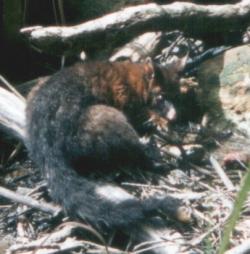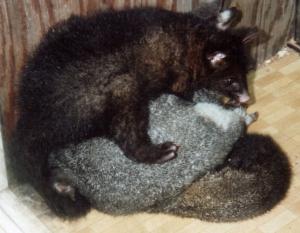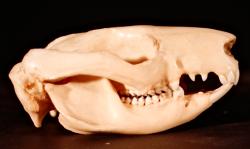
POSSUMS
SUPER COHORT MARSUPIALIA
COHORT AUSTRALIDELPHIA
ORDER DIPROTODONTIA
FAMILY PHALANGERIDAE
| The family Phalangeridae comprises the possums and
cuscuses; mostly small arboreal, creatures weighing between 1 to 6 kg.
In adapting to arboreal habitats, the phalangers have come to resemble many
primates in having prehensile tails, opposable
thumbs and big toes (halluces). Their large eyes, diets and nocturnal
behaviour resemble those of prosimian primates,
like bushbabies and lorises. Their tails are very similar to those
of New World Monkeys in being ridged on the ventral surface of the
distal portion. This increased surface area improves
traction when gripping and climbing.
Phalangers are mainly solitary, browsing herbivores feeding on eucalypt leaves and other vegetation but their non specialist dentition also enables them to eat insects, birds and egg. Many species are in danger of extinction, however brushtail possums are now serious pests in New Zealand and Australia. |  Picture of brushtail possum in New Zealand |
| Endangered species | Pest species |
Brushtail possum Trichosurus vulpecula
| Brushtail possums are the most common possum in Australia:
the size of a cat, they have pointed faces, long oval shaped ears
and a bushy tail. They vary in colour from black to silver gray to
golden. Black possums generally live in darker, wetter
forests than silver possums.
Originally forest animals, brushtail possums are found in a wide range of environments, from forests to cities. They are mainly solitary animals, marking their home-ranges by rubbing a scent produced by secretory glands on the chin, chest, and near the anus onto trees and bushes. |  |
| The brushtail possum has a diprotodont dentition. Its reduced incisors, canines and premolars, and simple low crowned molars favour an omnivorous diet of leaves, birds and eggs. |  Brushtail possum skull: I3/2; C1/0; P2/1; M 4/4. |
Possums have a gestation period of about 18 days and the young spend about 4-5 months in the mother's pouch. Like kangaroos, they can change the composition of their milk to suit young of different ages.
| Bandicoots | Dasyurids | Marsupial moles |
| Thylacine | Koala | Wombats |
| Kangaroos | Feathertail or pygmy glider |






